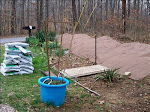February is a tough month. The weather can be relentless, and those sunny days are few and far between. I sit at the window like a cat, gazing out at the gardens. Although it’s not too early to start some seedlings, it’s too cold to put out seed in the ground, and I’m tired of my household projects. Let me rephrase that: I’m tired of having to do projects to get me through winter. I want to get my fingers in the dirt, to feel the “freshening breeze” on my face and neck, I long to be one with the earth again. I have a bad case of spring fever.
So what do we do in late February to get by?
1. Plan your garden layouts.
2. Check all your tools. Take the mower and tools that need spring checkups and sharpening to the shop now, before the rush.
3. Spread chicken manure on the garden beds.
4. Make a list of the seed you need. Set up a Seed Exchange with friends. Don’t forget flowers!
5. Get your seedling pots and trays in order.
Mix seedling dirt.
6. Plant below-ground seed now: carrots, onions, turnips, garlic, beets, potatoes. They grow best if planted after the full moon.
7. Plant peas on February 28th, the full moon day
What do YOU do during the winter lull? How do you get through garden fever? Planning seems to be key. Also staying in touch with other gardeners. Blogging about gardening helps, at least I can talk about the gardens and dream about July, when the gardens come to fruition and the long winter wait will seem to be worth it.
Saturday, February 27, 2010
Thursday, February 18, 2010
Cinderblock Composter
A quick way to make your raised bed gardens is to use cinder blocks to enclose the garden area. Cinder blocks are about $1.30 each. I like my gardens to be small enough to reach across, so I used 24 blocks for a cost of about $30.
Line the bottom of the area and under the cinder blocks with thick layers of newspaper to kill weeds.

Fill garden area with compost, leaves, sand and soil. Cover with a landscape cloth that allows rain to run through. Allow the heap to rest for a week. Then pour a beer over the whole pile. Cover.
Fill the holes in the concrete blocks with garden soil and plant with herbs and flowers. Petunias and marigolds help repel pests and beautify the cinder blocks.
Line the bottom of the area and under the cinder blocks with thick layers of newspaper to kill weeds.

Fill garden area with compost, leaves, sand and soil. Cover with a landscape cloth that allows rain to run through. Allow the heap to rest for a week. Then pour a beer over the whole pile. Cover.
Fill the holes in the concrete blocks with garden soil and plant with herbs and flowers. Petunias and marigolds help repel pests and beautify the cinder blocks.
Tuesday, February 2, 2010
More Compost News
Your compost should not smell bad. When you pack it in the garbage can mentioned in the former post, you should be careful to pack everything loosely. I sometimes spread a little dirt over the top of mine, but I use dirt sparingly. I follow the directions I’ve given on my posts.
Recently our composting garbage can filled up with compost layers, so Alan built a square wooden frame for the next raised garden bed in the back yard. We lined the bottom of the frame with a thick layer of newspaper to kill weeds. The inks and soy in the paper decay and are beneficial to compost. Next, we upended the garbage can. Try to keep from tipping over the pile. Pour a can or bottle of beer over the pile. Cover the pile with a tarp to keep the rain from washing out all the ingredients. My tarp allows water to slowly seep into the compost pile, wetting it and keeping the enzymes active.
Love your compost pile. Rake through the pile after a week, then once a week rake the pile backwards and forwards. Gradually, miraculously, a rick dark earth will form.
Recently our composting garbage can filled up with compost layers, so Alan built a square wooden frame for the next raised garden bed in the back yard. We lined the bottom of the frame with a thick layer of newspaper to kill weeds. The inks and soy in the paper decay and are beneficial to compost. Next, we upended the garbage can. Try to keep from tipping over the pile. Pour a can or bottle of beer over the pile. Cover the pile with a tarp to keep the rain from washing out all the ingredients. My tarp allows water to slowly seep into the compost pile, wetting it and keeping the enzymes active.
Love your compost pile. Rake through the pile after a week, then once a week rake the pile backwards and forwards. Gradually, miraculously, a rick dark earth will form.
Subscribe to:
Comments (Atom)


















